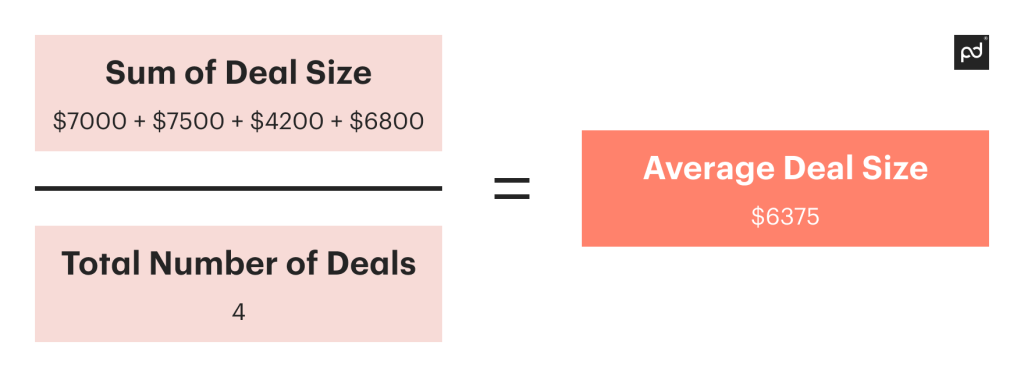As your company grows, you may find you have less resources available for closing each opportunity.
Your company’s sales managers only have a select number of sales reps to work with, and those reps only have a limited amount of time to close deals.
A good sales pipeline management strategy is essential because every potential opportunity uses up your most valuable resource — time.
Therefore, capitalizing on each opportunity in the most effective way possible means directly increasing the success of your conversion rate.
In order to solve this issue and make the most of your sales, it is essential to hierarchize new leads in your CRM software’s sales strategy.
This article will introduce you to tips and metrics to optimally track and prioritize your sales pipeline.
1. Determine your average deal size (ADS)
Calculating the average value of your deals is a good way to start putting your opportunities in order of importance.
To calculate it, simply add up the deal sizes (amounts) of each opportunity won in a specific time period and divide it by the total number of deals made in the same time period.
Let’s assume you closed four deals in a month, with each worth $7000, $7500, $4200, and $6800, respectively. Your average deal size (ADS) in this case is:

Then you can compare this data with either the total contract value (TCV) or lifetime value (LTV), depending on how you operate your quota structure, sales cycle, and other variables.
Why it matters: With this in mind, it will help you estimate the difficulty of getting new customers.
For example, if the TCV is significantly higher (3x or more) than your average deal size, you can consider it a red flag.
This is because deals with a high total value typically have shorter sales cycles and lower success rates.
Thus, taking into account these outliers and remaining realistic about the sales process is essential.
A risky deal can ruin your pipeline health and slow down your sales performance.
In this type of situation, it is best to let more experienced or better-performing salespeople handle these valuable opportunities.
2. Weigh the deals in your sales pipeline
Another way to prioritize different deals in your sales pipeline is to determine the weighted value.
To put it simply, each sales step has a greater or lesser chance of closing when you are on a deal.
Then, the idea is to assign a percentage representing the closing probability.
For example, let’s assume you’re in step 2 of a 6-step pipeline, then the probability of closing the deal is estimated at 33%.
After that, simply multiply the percentage by the value of the opportunities at the stage of the pipeline and use the result for sales forecasts.
Here is the formula to calculate the value of a weighted pipeline:
Probability of Closing * Deal Value = Weighted Value.
If we continue with the previous example — currently at step 2 of 6 — and assume a 33% chance of closing on a $200,000 TCV, the weighted value is as follows:

In this case, $66,666 would be included in the sales forecast based on the probability.
By repeating calculations for each deal of your pipeline (at whichever respective stage they are currently in) and adding up the probable totals, you will get your weighted sales forecast.
For example, suppose your pipeline looks like this below:
Deal 1: 50% probability of $20,000 deal = $10,000 weighted value.
Deal 2: 50% probability of $40,000 deal = $20,000 weighted value.
So your weighted sales forecast (adding totals) is $30,000 at this point in time.
Estimating the probability of closing the next stage in your CRM funnel software is the most difficult part.
The number of stages in a sales funnel, the size of the company, and the amount of time it takes to close a typical deal all influence these estimates.
Why it matters: The purpose of a weighted pipeline is to give a high-level impression of your sales opportunities.
This data has a twofold advantage for managing your sales.
First, it allows you to see the progress of each prospect in the pipeline, and second, it gives you an estimate of the probability of your prospect making a purchase.
Another indicator to consider is the sales pipeline coverage ratio. It is equal to the total value of opportunities to close in a period divided by the target for the same period.
It is particularly beneficial for measuring the quantity of pipeline you have compared to the quota you need to close and helps to complete the weighted value.
A decent pipeline coverage ratio is thought to be between 3 and 5.
Thus, with this method, you and your sales team can easily manage many opportunities simultaneously and follow each sales process step in detail.
In addition, as you move through the sales stages of your offer, the pipeline value and the revenue goals become more reliable with more data.
3. Measure the time to close a deal
It’s also interesting to look at how long it takes to close a deal in order to prioritize your sales pipeline.
This is actually the average sales cycle length, which you get by adding up the total number of days it took to close each sale, then dividing that sum by the total number of transactions.
Let’s assume you closed three deals in 60, 70, and 30 days, respectively. Thus, the average time to close a sale is 160/3 = approximately 53 days.
This data is very useful because it will allow you to estimate the close rate for similar deals in the future (in this example, 53 days).
You may take things a step further by calculating the sales pipeline velocity. This indicator will assist you in determining how quickly you make money.
Essentially, it refers to the rate at which leads travel through your pipeline and the value that new customers contribute over time.
Here is the formula:
(Number of Opportunities * ADS * Win Rate) / Sales Cycle Length = Sales Velocity
Use PandaDoc to speed up your transactions and keep tracks of analytics.
Streamlining the sales documentation process will give your sales reps more time to sell more.
Why it matters: Your sales leaders will become better decision-makers after examining this data, understanding the most promising opportunities with respect to accelerating the conversion rate for your sales pipeline.
For instance, winning opportunities are tested for an average of 18 days, whereas opportunities that have been present for 45 days are less likely to result in a deal.
4. Automate your proposal with PandaDoc
With the right sales pipeline metrics, sales managers will have better time management and the ability to prioritize their pipeline and optimize the number of leads accurately.
With PandaDoc, you can easily shorten the sales cycle by having the sales team utilize preconfigured templates, which further streamlines the decision-making process.
This will allow your team to reach their sales goals more efficiently by focusing on sales qualified leads, increasing your company’s conversion rate and thus improving the overall value of your sales pipeline.
Disclaimer
PandaDoc is not a law firm, or a substitute for an attorney or law firm. This page is not intended to and does not provide legal advice. Should you have legal questions on the validity of e-signatures or digital signatures and the enforceability thereof, please consult with an attorney or law firm. Use of PandaDocs services are governed by our Terms of Use and Privacy Policy.
Originally published January 15, 2018, updated April 3, 2023


